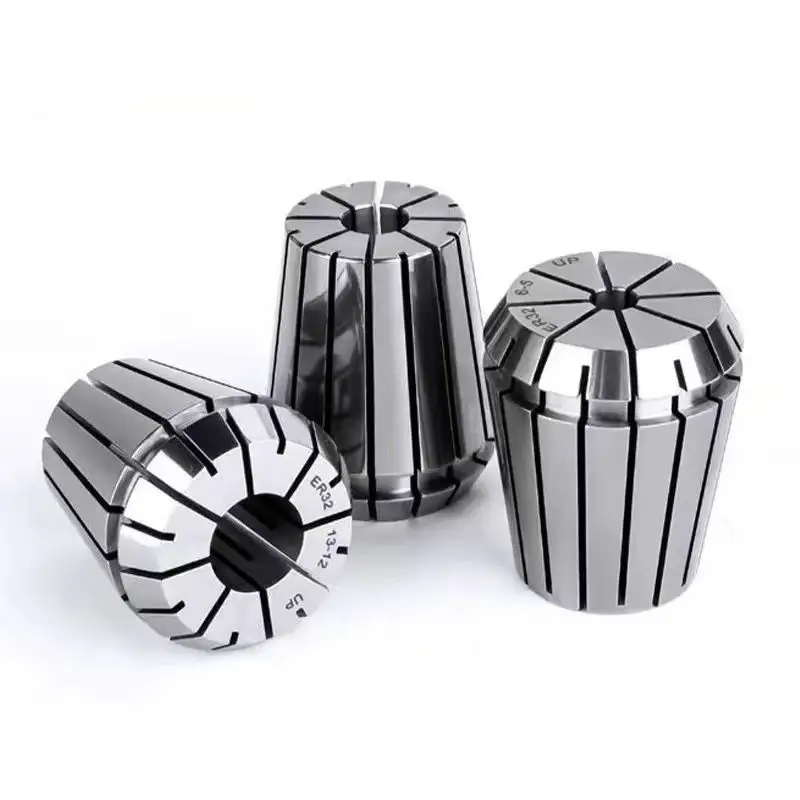Collet chucks are indispensable in precision machining, offering unmatched accuracy and efficiency for holding workpieces or cutting tools. Whether in CNC machining, lathes, or milling operations, these devices have revolutionized manufacturing workflows by combining speed, stability, and adaptability. Let’s explore their mechanics, types, applications, and future innovations.
What is a Collet Chuck?
A collet chuck consists of two main components: a collet (a segmented, tapered sleeve typically made of spring steel) and a chuck body that applies clamping force. When tightened, the collet compresses uniformly around a tool or workpiece, ensuring minimal runout and high concentricity. This design contrasts with traditional chucks, which rely on jaws and may introduce slight misalignment.
Key advantages include:
- High Precision: Achieves runout as low as 0.005 mm, critical for tasks like micro-machining or aerospace components.
- Even Clamping Force: Distributes pressure evenly, reducing deformation in delicate parts.
- Vibration Damping: Enhances surface finish and extends tool life.
Types of Collet Chucks
Different collet systems cater to specific applications:
- ER Collet Chucks
- Range: ER-8 to ER-50 (numbers denote the collet’s maximum opening in mm).
- Use: Ideal for CNC machining, offering flexibility with a 1 mm clamping range per collet. Widely adopted due to DIN 6499 standardization.
- 5C Collet Chucks
- Range: 1/16″ to 1-1/8″, commonly used in lathes for round, square, or hexagonal workpieces.
- R8 Collet Chucks
- Range: 1/8″ to 3/4″, designed for Bridgeport-style milling machines.
- Autolock Collet Chucks
- Feature: Threaded shanks prevent tool slippage, popularized by Clarkson in the 1940s.
Applications Across Industries
Collet chucks excel in scenarios demanding speed and precision:
- CNC Machining: Rapid tool changes and high-speed operations benefit from ER collets.
- Lathe Turning: 5C collets secure slender workpieces, reducing runout during second operations.
- Grinding and Drilling: Ensures stability for small parts and minimizes deflection.
- High-Speed Milling: Lightweight collet chucks mitigate centrifugal force, maintaining clamping force at high RPMs.
Choosing the Right Collet Chuck
Consider these factors:
- Clamping Range: Match collet size to tool/workpiece diameter (e.g., ER collets for flexibility, 5C for multi-shape stock).
- Precision Needs: Opt for ER or 5C systems for sub-0.001″ tolerances.
- Machine Compatibility: Ensure the chuck’s taper (e.g., NMTB 30) aligns with the spindle.
- Material and Coating: High-grade steel or anti-corrosion coatings enhance durability.
Maintenance and Future Trends
Maintenance Tips:
- Regularly clean collets to prevent debris buildup.
- Lubricate moving parts to reduce wear.
- Inspect for wear on gripping surfaces.
Future Innovations:
- Smart Collet Chucks: Integration with IoT for real-time monitoring.
- Automated Quick-Change Systems: Reducing downtime in high-volume production.
- Sustainable Materials: Eco-friendly alloys to minimize waste.
Collet Chucks vs. Traditional Chucks
While standard three-jaw chucks offer versatility, collet chucks outperform in precision and speed. For example:
- Speed: Collet chucks accelerate faster due to lower mass.
- Centrifugal Force: Unlike jaw chucks, collets maintain clamping force at high RPMs.
- Lot Sizes: Collets reduce changeover time for small or large batches.
Conclusion
Collet chucks are the backbone of modern precision machining, balancing speed, accuracy, and adaptability. From ER systems dominating CNC workshops to specialized 5C setups in lathes, their evolution continues to shape manufacturing efficiency. As automation and smart technologies advance, collet chucks will remain pivotal in achieving the next frontier of industrial innovation.

